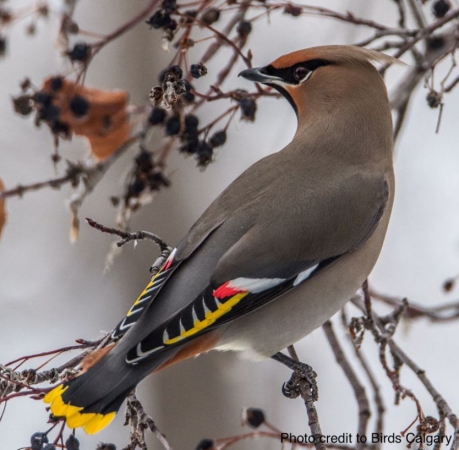Bohemian Waxwings are the winter waxwings in Alberta while the Cedar Waxwing is generally our summer resident.
Description: The Bohemian is larger at 54g, has white bars on the wings, and rusty coloured under the tail. The smaller Cedar Waxwing is only 32g. Both birds have the distinct black face mask and yellow tipped tails.
Migration: These birds begin arriving back in Alberta in September and leave the province to head north to their breeding range in April.
Food: Both species of waxwings that live in North America feed on insects in summer months, along with fruit, but live mostly on berries and crab apples during colder months.
Habitat: Waxwings can be seen in a wide range of habitats and will roam great distances in the winter in search of food. They are a common sight near cities and yards due to the increase of fruit trees planted by people.
Breeding: Bohemians are monogamous and breed in the far north in an area with plenty of food and coniferous trees. They are not territorial and may not necessarily go back to the same area to breed the next year. They lay an average of 6 eggs in June and July that are incubated for approximately 2 weeks by the female alone. The male brings her berries and keeps her looked after during that time.
Predators: The most common predators of these lovely, little birds are other birds such as falcons and small hawks. Merlin, Cooper’s Hawk, and Sharp-shinned Hawk are fast flying predators that are skilled at catching little birds. Many birds are killed when colliding with windows. When a bird sees the reflection of sky and trees in a window, they do not realize there is actually a window in the trees they see.
Interesting Facts: Waxwings live together in huge flocks during winter months. These flocks that may be as large as 2-3,000 birds descend on a yard with berries or apples and stay until the fruit is gone, then move on to the next yard. The seeds of the fruit can be spread a long distance through the feces of these birds.
Waxwings are very quiet, passive little birds often showing very little fear of humans when they are near.
Waxwings eat huge amounts of berries with one individual being recorded as eating between 600-1000 cotoneaster berries in six hours.
At MRWC: As late winter turns to early spring and days get longer, the sun is a little higher in the sky. This changes the way we see reflections on windows and we believe this is one reason that far more Bohemian Waxwings injure themselves and come to our hospital that time of year. During some winters the numbers have been so high that come spring we have our own flock to release. We allow them to exercise in the indoor pond for a few days before release and when the weather is sunny and nice outside, we simply open the door and a cloud of waxwings take off from the building.


